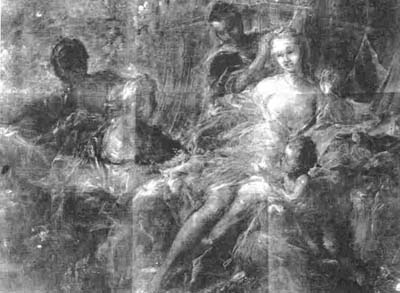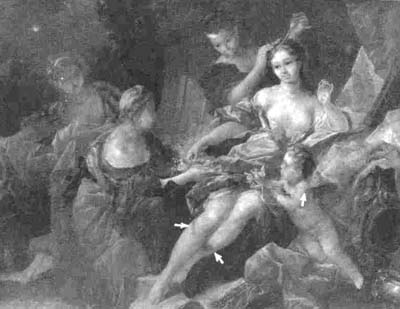
Bulletin 2 (I:2), December 1963
Home
Français
Introduction
History
Annual Index
Author &
Subject
Credits
Contact



![]()
![]()
![]()
![]()
From the Laboratory of the National
Gallery
by Nathan Stolow,
Chief Conservation and Scientific Research
Division
Pages
1 | 2
| 3 | 4
| 5
The Toilet of Venus
By Boucher
In the latter part of 1961 this painting, from the collection of
the Nationalmuseum, Stockholm, was circulated in Canada as part of
the Héritage de France exhibition. (19) On arrival in
Montreal it was discovered that certain areas of paint were in
danger of falling away, and as the painting had never been lined
since 1746 (its date of execution) there was every reason to suspect
that the canvas was in a very delicate state of preservation. It was
also probable that it might not stand up well to the hazards of
transportation during a Canadian winter. The exhibition organizers,
in consultation with the Swedish authorities, decided that the best
course of action was to transport it under careful supervision to
Ottawa where it could be examined at the National Gallery, with the
view to carrying out whatever conservation treatment would be deemed
necessary to ensure the safe return of the painting to Stockholm.
This, of course, presented a unique opportunity for the laboratory
of the National Gallery to carry out documentation, examination,
and conservation treatment on a painting of very great merit. During
the winter and spring of 1962 the painting was examined in minute
detail to ascertain its true condition. The painting was
photographed in black and white, in colour, by ultra-violet
fluorescence, infra red, and radiography. In addition, a study was
made of the palette of Boucher by means of cross-sections of minute
fragments of paint removed from along the folded edges of the
painting.
The painting had never been lined. The stretcher dimensions of the
painting were 38 1/2 by 50 3/4 inches, and it was observed that as much
as 3/4 of an inch of the original painting was folded over this
stretcher on all sides. At an early stage of the examination it was
considered important to reclaim as much as possible of the
previously hidden edges of the painting by constructing a larger
stretcher, and by modifying the sight dimensions of the frame. The
incompleteness of the composition of The Toilet of Venus suggested
that the original painting was somewhat larger than that now shown.
No documentation has yet been discovered which reveals the original
composition. (20) Examination of the folded edges of the painting,
and the surface of the painting proper, allowed one to establish
areas of overpainting, particularly along the upper edges. This has
been detailed in the study of blue sky colour (Figs. 15 and 16). By
combining the evidence of radiography (Fig. 13), infra-red (Fig.
14), ultra-violet photography, and microscopic studies, one was able
to arrive at a fairly complete assessment of the areas of restoration, repaint, and regions of fragility. A typical structure of
Boucher paint from the folded-over edge is shown in Figs. 17 and 18.
On the basis of the examinations carried out it was possible to
establish a method of treatment: e.g., lining (using the hot table
to consolidate fragile paint and canvas, especially loose paint
film), removal of the yellowed layer of natural resin varnish with
solvents, applying lined and cleaned painting to an enlarged
stretcher, inpainting where necessary, and finally, the application of a suitable resin varnish coating. (21, 22) The following are
brief notes from the treatment report:
The entire surface of the painting was faced with wet strength
tissue paper using dilute parchment size. The tacks were removed,
and it was then found that an old repair 1/2" diameter at
upper edge 21" from right was firmly glued to the stretcher
member. The only manner to free the support from its stretcher frame
safely was to cut away the part of the stretcher affected and to
chip away the wood from the canvas surface. After filling tack holes
with gesso (calcium carbonate and dilute parchment size), as well
as other losses, facing paper was applied, to these folded-over
edges. The back of the support was vacuumed, the old paper patches
removed and all knots: and other imperfections sanded level.
Impregnation with wax-resin adhesive, 4 parts beeswax: 1 part damar
resin 1 part gum elemi, was carried out on the vacuum hot table. The
new unbleached linen lining canvas, warp 32, weft 27 double threads
per inch (similar to that of the painting) , was stretched on a
temporary frame, moistened with water, allowed to dry, and then
restretched. The lining canvas was then impregnated with the
wax-resin composition on the vacuum hot table. The lining was
carried out on the vacuum hot table, using an underlayer of wide
blotting paper to prevent imprinting of the texture of the canvas
on the paint surface when vacuum pressure was applied. (23) Time and
temperatures were recorded graphically. The duration of the heating
process was approximately 40 minutes, with a maximum temperature of
75 degrees centigrade. The entire heating and cooling cycle lasted
approximately 70 minutes, and the vacuum pressure measured at the
edges was in the vicinity of 2/3 of an atmosphere.
After lining the facing tissue was removed using a damp cloth, and
excess wax on the paint surface removed with an emulsion of
petroleum hydrocarbons and water. The gesso fills were also levelled
at the same time. The cleaning of the old discoloured varnish was
carried out with the solvent mixture of equal parts of isobutyl alcohol, diacetone, and shell sol
715. (24) Acetone was used in some areas
where the resin appeared to be more stubborn, and in places of
overpainting, e.g., upper left sky, right hand and right leg of
Venus, left shoulder and head of putti at right. No attempt was made
however to remove the overpainted drapery, 4" x 2" at
upper edge, 16" from right hand margin, and the later paint, 1
1/2" x 2" at upper edge, 30" from right.
In order to conform with the new dimensions of the painting, brought
about by the reclaimed margins, a new stretcher was made of
basswood. The new dimensions were 40 1/8" x 52 1/2",
compared with 38 1/2" x 50 3/4" for the original one. The
lined painting was fixed to the new stretcher with tin-plated tacks.
A coat of damar resin in xylene was applied before inpainting. A
grey water colour priming was added to all gesso fills and pigment
ground in normal butyl methacrylate and xylene was employed for
inpainting. The final coating was carried out with normal butyl
methacrylate in xylene sprayed on after two weeks drying time.
Oak strips painted dull black were screwed to all four edges of the
painting, and projected 1/8" forward from the picture surface.
This provided a protective edge as the picture rested in its frame.
The rabbet of the frame was adapted to the new stretcher dimensions
by carving out approximately 1/4" after the previously
installed 3/4" liner was removed. The picture was secured in the
frame by placing a 3/4" raised rim on the frame back to
accommodate stretcher thickness (1 1/8") and screwing on a
1/8" thick sheet of tempered masonite as protective back.
Next Page | Other Investigations
1 | 2 | 3
| 4 | 5
Annual Index | Author & Subject | Credits | Contact
This digital collection was produced
under contract to Canada's Digital Collections program, Industry Canada.
"Digital
Collections Program, Copyright
© National Gallery of Canada 2001"